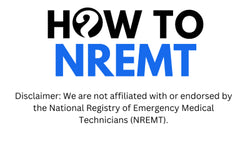Have you ever looked at an emergency medical services provider gracefully tending to patients and thought, “I’d like to give back to society, too?” Well, now you can. The wait is over. If you’ve been wanting to pursue your career as an EMT in New Mexico.
However, embarking on this journey may seem daunting with a myriad of information available on the internet. At How To NREMT, we aim to ease the process with this guide.
You’ll learn about the steps involved in the process of getting certified in New Mexico. From EMT training to the NREMT cognitive exam, this guide walks you through the entire process, ensuring your success in the first attempt!
Here’s a clear breakdown of what’s involved in getting your state licensure and EMT certification.
Step 01

Meeting the Basic Eligibility Criteria
Before you begin your prep and train in an EMT program, it’s important to ensure that you check off all the following boxes:
- Minimum Age Requirement: A candidate must be at least 17 years of age to complete the EMT training.
- Minimum Education Requirement: A candidate must have a high school diploma or GED to become an EMT in New Mexico.
- Pass Background Checks: Criminal background checks are part of the EMT application process in New Mexico. The candidate must also show good moral character.
- Current CPR/BLS Certification: A candidate must hold a current CPR/BLS certification. This certification must be obtained via blended learning or classroom and includes a practical skill assessment. Online-only CPR certificates may not be accepted by institutions or employers.
- Parental Consent: For candidates under the age of 18 years, a parental consent form is required.
Step 02

Enroll In a New Mexico-Approved EMT Training Program
Once you meet the basics, you can proceed to enroll in a state-approved EMT training program. These programs are overseen by the New Mexico Emergency Medical Services Bureau (EMS Bureau) and are offered at community colleges, technical schools, and local EMS agencies.
The training includes classroom instruction, skills labs, and clinical experience. You’ll cover patient care, trauma, medical emergencies, and EMS operations. After completion, you become eligible to take the NREMT cognitive exam.
But wait! How do you prepare for this important exam? That’s the third step in becoming an EMT.
Step 03

Prepare For and Take the NREMT Cognitive Exam
The NREMT cognitive exam is a critical test that assesses how you react in emergencies. It’s not based on rote memorization. Instead, it tests your ability to tend to patients’ needs in real-time.
As a computer-adaptive test (CAT), the difficulty level of each question depends on how well you answered the question before that. Thus, there’s no way to determine if you’re doing well or not.
The test questions can range from 70 to 120 on the following updated course domains:
- Scene Size-Up and Safety
- Primary Assessment
- Secondary Assessment
- Patient Treatment and Transport
- Operations
Note: Items related to pediatric patient care are integrated throughout all domains.
Knowing the exam format is only a fraction of what is involved in the cognitive exam. What matters is how you prepare, and that is where many candidates fail. Not because they didn’t study. It’s the opposite: they studied the wrong way. That’s where we come in as your guiding light. With our AI-powered EMT tutor and NREMT cognitive exam practice questions, you can increase your chances of success on your very first attempt.
Step 04

Apply for New Mexico State Licensure
Once you complete your state-approved training and pass the NREMT cognitive exam, you can apply for the EMT licensure through the New Mexico EMS Licensing Portal.
Upload all the following documents on the portal:
- Proof of a state-approved EMT training course
- Passing result of the NREMT cognitive exam
- Background check
- Current CPR certificate
- Application form with fee
Then it’s just a matter of a moment before your EMT licensure arrives.
Step 05

Ensure Your Licensure Remains Current
You must ensure your EMT certificate remains active. In New Mexico, the professionals must renew their certification every two years. Late renewals can affect your work.
NREMT vs. New Mexico Requirements: Know the Differences
| Requirements | National | State |
|---|---|---|
| NREMT cognitive exam | Required | Required |
| ALS psychomotor skills | Discontinued | Required |
| Current CPR | Required | Required |
| State-approved EMT course | Required | Required |
| Background check | Not applicable | Required |
| State licensure application | Not applicable | Required |
Note: The ALS psychomotor skills test is only a state requirement and is no longer applicable at the National level.

- Choosing a selection results in a full page refresh.


